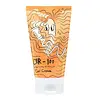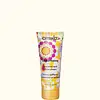What's inside
What's inside
 Key Ingredients
Key Ingredients

No key ingredients
 Benefits
Benefits

 Concerns
Concerns

 Ingredients Side-by-side
Ingredients Side-by-side

Water
Skin ConditioningPropylene Glycol
HumectantCyclopentasiloxane
EmollientDimethicone
EmollientGlycerin
HumectantPvp
Emulsion StabilisingPolyacrylamide
Hydroxyethyl Acrylate/Sodium Acryloyldimethyl Taurate Copolymer
Emulsion StabilisingParfum
MaskingC13-14 Isoparaffin
EmollientTromethamine
Buffering1,2-Hexanediol
Skin ConditioningCaprylyl Glycol
EmollientButylene Glycol
HumectantLaureth-7
EmulsifyingSodium Acrylate/Sodium Acryloyldimethyl Taurate Copolymer
Emulsion StabilisingIsohexadecane
EmollientIllicium Verum Fruit Extract
PerfumingPhenoxyethanol
PreservativePolysorbate 80
EmulsifyingDisodium EDTA
Oenothera Biennis Oil
EmollientArgania Spinosa Kernel Oil
EmollientChamomilla Recutita Flower Oil
MaskingSorbitan Oleate
EmulsifyingCyclomethicone
EmollientHydrolyzed Collagen
EmollientGelatin
Hydrolyzed Keratin
HumectantAvena Sativa Protein Extract
Skin ConditioningRosmarinus Officinalis Leaf Extract
AntimicrobialLavandula Angustifolia Flower Extract
CleansingThymus Vulgaris Flower/Leaf/Stem Extract
Skin ConditioningOriganum Vulgare Extract
Skin ConditioningHydrolyzed Corn Protein
Skin ConditioningHydrolyzed Wheat Protein
Skin ConditioningHydrolyzed Soy Protein
HumectantWater, Propylene Glycol, Cyclopentasiloxane, Dimethicone, Glycerin, Pvp, Polyacrylamide, Hydroxyethyl Acrylate/Sodium Acryloyldimethyl Taurate Copolymer, Parfum, C13-14 Isoparaffin, Tromethamine, 1,2-Hexanediol, Caprylyl Glycol, Butylene Glycol, Laureth-7, Sodium Acrylate/Sodium Acryloyldimethyl Taurate Copolymer, Isohexadecane, Illicium Verum Fruit Extract, Phenoxyethanol, Polysorbate 80, Disodium EDTA, Oenothera Biennis Oil, Argania Spinosa Kernel Oil, Chamomilla Recutita Flower Oil, Sorbitan Oleate, Cyclomethicone, Hydrolyzed Collagen, Gelatin, Hydrolyzed Keratin, Avena Sativa Protein Extract, Rosmarinus Officinalis Leaf Extract, Lavandula Angustifolia Flower Extract, Thymus Vulgaris Flower/Leaf/Stem Extract, Origanum Vulgare Extract, Hydrolyzed Corn Protein, Hydrolyzed Wheat Protein, Hydrolyzed Soy Protein
Water
Skin ConditioningButylene Glycol
HumectantDimethicone
EmollientPhenyl Trimethicone
Skin ConditioningPolysorbate 80
EmulsifyingDimethiconol
EmollientSorbitan Oleate
EmulsifyingAcrylamide/Sodium Acryloyldimethyltaurate Copolymer
Emulsion StabilisingHippophae Rhamnoides Fruit/Seed Oil
AntimicrobialSodium Cocoyl Amino Acids
CleansingMica
Cosmetic ColorantPotassium Dimethicone PEG-7 Panthenyl Phosphate
Skin ConditioningCinnamidopropyltrimonium Chloride
Hydroxyethyl Acrylate/Sodium Acryloyldimethyl Taurate Copolymer
Emulsion StabilisingCitric Acid
BufferingSodium Phytate
Sodium Sarcosinate
Isohexadecane
EmollientPropylene Glycol
HumectantPhenoxyethanol
PreservativeTetrasodium EDTA
Sorbitan Isostearate
EmulsifyingParfum
MaskingBenzyl Benzoate
AntimicrobialHydroxycitronellal
PerfumingLimonene
PerfumingCitronellol
PerfumingCoumarin
PerfumingCI 77891
Cosmetic ColorantWater, Butylene Glycol, Dimethicone, Phenyl Trimethicone, Polysorbate 80, Dimethiconol, Sorbitan Oleate, Acrylamide/Sodium Acryloyldimethyltaurate Copolymer, Hippophae Rhamnoides Fruit/Seed Oil, Sodium Cocoyl Amino Acids, Mica, Potassium Dimethicone PEG-7 Panthenyl Phosphate, Cinnamidopropyltrimonium Chloride, Hydroxyethyl Acrylate/Sodium Acryloyldimethyl Taurate Copolymer, Citric Acid, Sodium Phytate, Sodium Sarcosinate, Isohexadecane, Propylene Glycol, Phenoxyethanol, Tetrasodium EDTA, Sorbitan Isostearate, Parfum, Benzyl Benzoate, Hydroxycitronellal, Limonene, Citronellol, Coumarin, CI 77891
 Reviews
Reviews

Ingredients Explained
These ingredients are found in both products.
Ingredients higher up in an ingredient list are typically present in a larger amount.
Butylene Glycol (or BG) is used within cosmetic products for a few different reasons:
Overall, Butylene Glycol is a safe and well-rounded ingredient that works well with other ingredients.
Though this ingredient works well with most skin types, some people with sensitive skin may experience a reaction such as allergic rashes, closed comedones, or itchiness.
Learn more about Butylene GlycolDimethicone is a type of synthetic silicone created from natural materials such as quartz.
What it does:
Dimethicone comes in different viscosities:
Depending on the viscosity, dimethicone has different properties.
Ingredients lists don't always show which type is used, so we recommend reaching out to the brand if you have questions about the viscosity.
This ingredient is unlikely to cause irritation because it does not get absorbed into skin. However, people with silicone allergies should be careful about using this ingredient.
Note: Dimethicone may contribute to pilling. This is because it is not oil or water soluble, so pilling may occur when layered with products. When mixed with heavy oils in a formula, the outcome is also quite greasy.
Learn more about DimethiconeThis is a synthetic polymer. It helps improve the texture of products by adding thickness and gel-like feel.
It is also an emulsifer, meaning it prevents ingredients such as oil and water from separating. It also helps evenly disperse other ingredients.
Isohexadecane is added to enhance texture, emulsify, and to help cleanse. It is an isoparrafin. It is a component of petrolatum.
Due to its large size, Isohexadecane is not absorbed by the skin. Instead, it sits on top and acts as an emollient. Emollients help keep your skin soft and smooth by trapping moisture within.
Isohexadecane is often used in products designed to help oily skin. It is lightweight and non-greasy while helping to moisturize. When mixed with silicones, it gives a product a silky feel.
Learn more about IsohexadecaneParfum is a catch-all term for an ingredient or more that is used to give a scent to products.
Also called "fragrance", this ingredient can be a blend of hundreds of chemicals or plant oils. This means every product with "fragrance" or "parfum" in the ingredients list is a different mixture.
For instance, Habanolide is a proprietary trade name for a specific aroma chemical. When used as a fragrance ingredient in cosmetics, most aroma chemicals fall under the broad labeling category of “FRAGRANCE” or “PARFUM” according to EU and US regulations.
The term 'parfum' or 'fragrance' is not regulated in many countries. In many cases, it is up to the brand to define this term.
For instance, many brands choose to label themselves as "fragrance-free" because they are not using synthetic fragrances. However, their products may still contain ingredients such as essential oils that are considered a fragrance by INCI standards.
One example is Calendula flower extract. Calendula is an essential oil that still imparts a scent or 'fragrance'.
Depending on the blend, the ingredients in the mixture can cause allergies and sensitivities on the skin. Some ingredients that are known EU allergens include linalool and citronellol.
Parfum can also be used to mask or cover an unpleasant scent.
The bottom line is: not all fragrances/parfum/ingredients are created equally. If you are worried about fragrances, we recommend taking a closer look at an ingredient. And of course, we always recommend speaking with a professional.
Learn more about ParfumPhenoxyethanol is a preservative that has germicide, antimicrobial, and aromatic properties. Studies show that phenoxyethanol can prevent microbial growth. By itself, it has a scent that is similar to that of a rose.
It's often used in formulations along with Caprylyl Glycol to preserve the shelf life of products.
Polysorbate 80 is a surfactant and emulsifier. It is used to keep ingredients together, and prevent oils and waters from separating.
It is made from polyethoxylated sorbitan and oleic acid. This ingredient can be found in cosmetics, foods, and medicine. It is water-soluble.
Polysorbate 80 may not be fungal acne safe.
Learn more about Polysorbate 80Propylene Glycol is an odorless, colorless liquid. As a humectant, it helps skin retain moisture. It also aids in delivering active ingredients.
Another role of this ingredient is preventing a product from melting or freezing. Propylene glycol also adds antimicrobrial properties to a product, elongating product lifespan.
This ingredient is considered an organic alcohol and commonly added into both cosmetics and foods.
Those with sensitive skin or conditions may develop a rash when using this ingredient.
Learn more about Propylene GlycolSorbitan Oleate is created from compounds in oleic acid and sorbitol.
It is used to stabilize a product by preventing ingredients from separating. Emulsifiers help keep ingredients together, such as oils and water.
According to a manufacturer, the ingredient Sorbitan Monooleate shares an INCI name with this one.
Sorbitan Oleate may not be fungal acne safe. It can also worsen oily skin.
Learn more about Sorbitan OleateWater. It's the most common cosmetic ingredient of all. You'll usually see it at the top of ingredient lists, meaning that it makes up the largest part of the product.
So why is it so popular? Water most often acts as a solvent - this means that it helps dissolve other ingredients into the formulation.
You'll also recognize water as that liquid we all need to stay alive. If you see this, drink a glass of water. Stay hydrated!
Learn more about Water